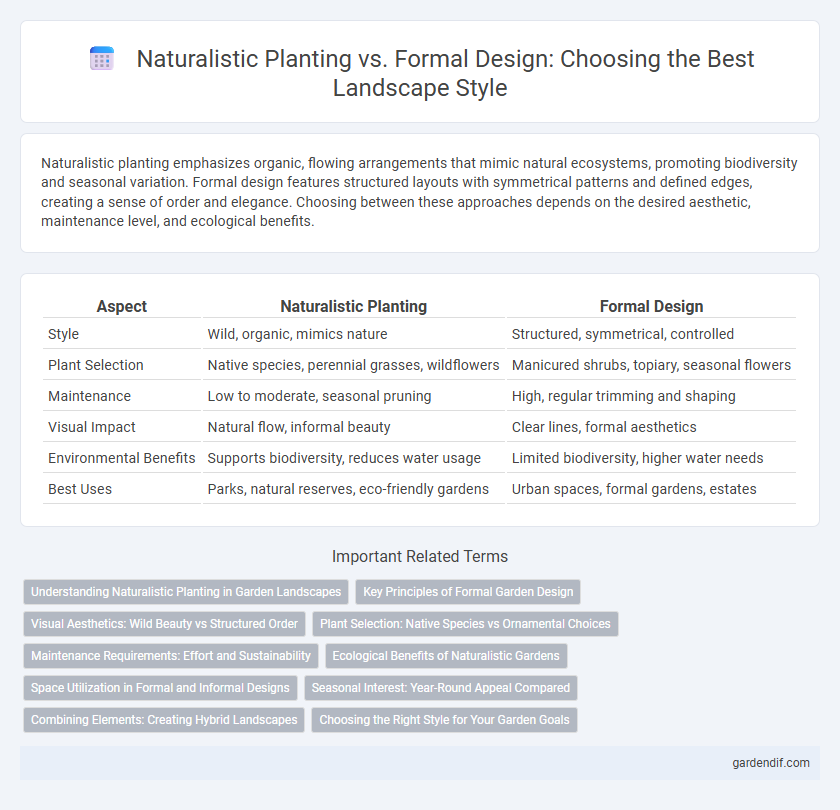
Naturalistic Planting vs Formal Design Illustration
Naturalistic planting emphasizes organic, flowing arrangements that mimic natural ecosystems, promoting biodiversity and seasonal variation. Formal design features structured layouts with symmetrical patterns and defined edges, creating a sense of order and elegance. Choosing between these approaches depends on the desired aesthetic, maintenance level, and ecological benefits.
Table of Comparison
| Aspect | Naturalistic Planting | Formal Design |
|---|---|---|
| Style | Wild, organic, mimics nature | Structured, symmetrical, controlled |
| Plant Selection | Native species, perennial grasses, wildflowers | Manicured shrubs, topiary, seasonal flowers |
| Maintenance | Low to moderate, seasonal pruning | High, regular trimming and shaping |
| Visual Impact | Natural flow, informal beauty | Clear lines, formal aesthetics |
| Environmental Benefits | Supports biodiversity, reduces water usage | Limited biodiversity, higher water needs |
| Best Uses | Parks, natural reserves, eco-friendly gardens | Urban spaces, formal gardens, estates |
Understanding Naturalistic Planting in Garden Landscapes
Naturalistic planting in garden landscapes emphasizes native species and ecological patterns, promoting biodiversity and resilience. This approach replicates natural ecosystems by using diverse plant combinations that support local wildlife and require less maintenance. Unlike formal design, naturalistic planting prioritizes irregular shapes and seasonal changes, creating a dynamic and sustainable garden environment.
Key Principles of Formal Garden Design
Formal garden design emphasizes symmetry, geometric shapes, and structured layouts to create visually balanced and orderly landscapes. Key principles include the use of axial lines, carefully trimmed hedges, and repetitive patterns to establish a clear sense of control and harmony. This style contrasts with naturalistic planting by prioritizing precision and human-imposed order over organic growth and randomness.
Visual Aesthetics: Wild Beauty vs Structured Order
Naturalistic planting emphasizes wild beauty through organic forms, irregular patterns, and native species that blend seamlessly with the environment. Formal design prioritizes structured order, using symmetrical layouts, geometric shapes, and carefully pruned plants to create clear lines and controlled aesthetics. Visual aesthetics in landscape reflect the contrast between untamed, spontaneous growth and meticulous, intentional organization.
Plant Selection: Native Species vs Ornamental Choices
Naturalistic planting emphasizes native species adapted to local climates, promoting biodiversity and requiring less maintenance, whereas formal design relies on ornamental choices for precise aesthetics and structured layouts. Native plants support local wildlife and soil health, creating sustainable landscapes, while ornamental plants offer vibrant color contrasts and seasonal interest tailored to design intentions. Selecting between these approaches balances ecological benefits with aesthetic preferences in landscape planning.
Maintenance Requirements: Effort and Sustainability
Naturalistic planting typically demands lower maintenance due to its reliance on native species adapted to local conditions, which reduces the need for watering, fertilizing, and pest control, promoting sustainability. Formal design requires regular pruning, mowing, and precise upkeep to maintain symmetry and structure, leading to higher labor and resource input. This increased effort in formal landscapes often results in greater energy consumption and waste, making naturalistic planting a more eco-friendly and cost-effective maintenance choice.
Ecological Benefits of Naturalistic Gardens
Naturalistic planting enhances biodiversity by creating habitats that support pollinators, birds, and beneficial insects, promoting ecosystem stability. These gardens improve soil health through diverse root structures that prevent erosion and increase organic matter. By using native plants and minimizing water and chemical inputs, naturalistic designs contribute to sustainable landscape management and reduce environmental impact.
Space Utilization in Formal and Informal Designs
Formal landscape design maximizes space utilization through structured layouts, geometric patterns, and defined boundaries that create organized outdoor areas ideal for specific functions. Naturalistic planting embraces informal, flowing arrangements that mimic native ecosystems, promoting biodiversity but often resulting in less precisely defined spaces. Both approaches balance aesthetic goals with spatial efficiency, where formal design prioritizes clarity and order, while naturalistic planting favors ecological integration and organic spatial flow.
Seasonal Interest: Year-Round Appeal Compared
Naturalistic planting offers dynamic seasonal interest by emphasizing native species that transform throughout the year, showcasing vibrant spring blooms, lush summer foliage, and striking autumn colors. Formal design maintains structured, symmetrical layouts with evergreen shrubs and perennial borders that provide consistent but less varied year-round appeal. Balancing naturalistic elements with formal features can create landscapes that combine seasonal diversity with enduring visual order.
Combining Elements: Creating Hybrid Landscapes
Combining naturalistic planting with formal design creates hybrid landscapes that balance structured geometry and organic growth, enhancing both aesthetic appeal and ecological function. These landscapes incorporate native grasses, perennials, and asymmetrical patterns alongside manicured hedges, gravel paths, and defined borders to achieve a dynamic interplay of textures and forms. The integration fosters biodiversity, supports pollinators, and allows for seasonal variation while maintaining framework and order characteristic of formal gardens.
Choosing the Right Style for Your Garden Goals
Naturalistic planting emphasizes biodiversity, native species, and ecological balance, creating a garden that blends seamlessly with the local environment. Formal design prioritizes symmetry, structured layouts, and manicured plants, offering a refined and orderly aesthetic ideal for showcasing architectural elements. Selecting the right style depends on whether the goal is to foster sustainable habitats or achieve visually controlled elegance.
Naturalistic Planting vs Formal Design Infographic

 gardendif.com
gardendif.com